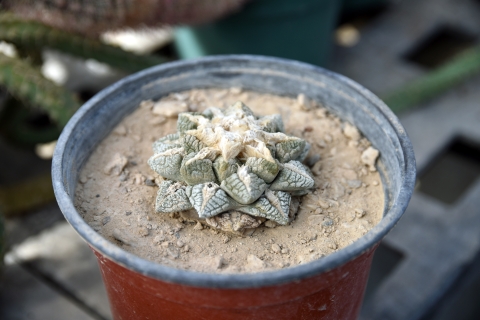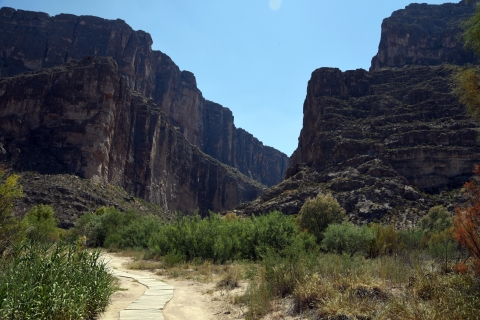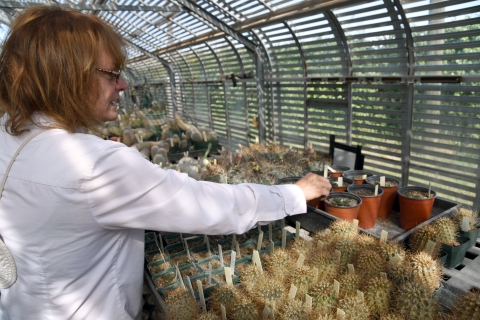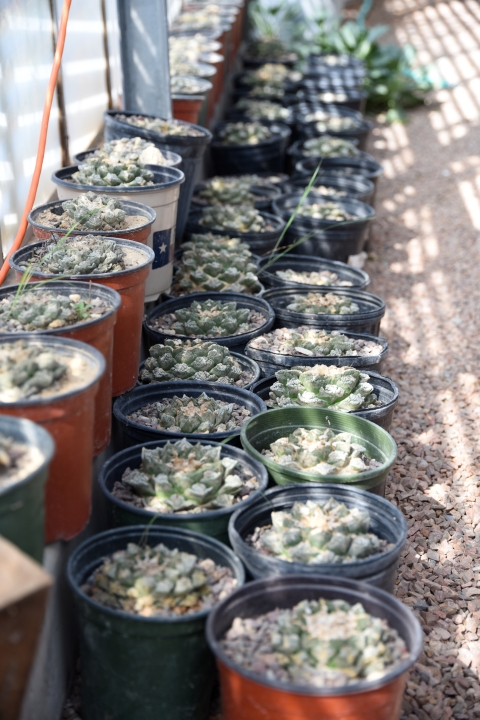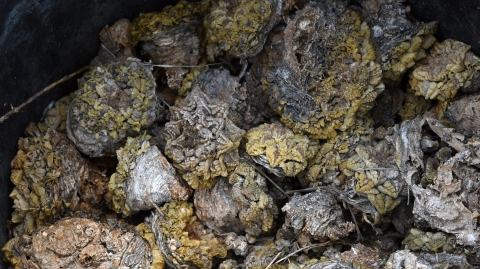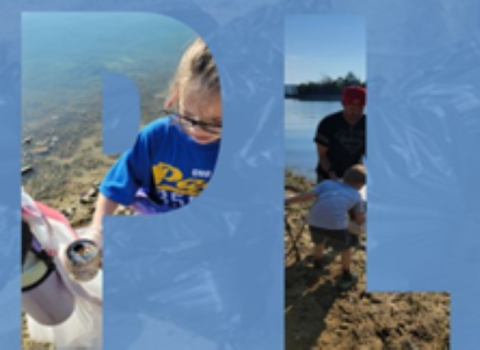After years of investigation, four cactus traffickers were sentenced for their role in the illegal harvest, sale, and/or transportation of the protected living rock (Ariocarpus fissuratus), a thornless cactus found only in the Big Bend region of Texas and northeastern Mexico.
The defendants were sentenced to a combined total of nine years of probation, one year of unsupervised probation, and they were also ordered to pay a total of $118,804 in fines and restitution, and forfeit 17 firearms. There are several more defendants in this case. The fight to stop the illegal harvest of the living rock cactus is ongoing.
These arrests and sentencings come from a concerted effort between multiple agencies, led by special agents of the U.S. Fish and Wildlife Service (FWS), in partnership with Homeland Security Investigations (HSI), U.S. Department of Justice Environmental Crimes Unit, U.S. Postal Inspection Service, the National Park Service (NPS), Texas Parks and Wildlife Department, and Sul Ross State University.
FWS Special Agent (SA) Eric Jumper of San Antonio, Texas, was the lead agent for the case.
“Never in a million years did I expect to investigate cactus smuggling as a federal officer,” said SA Jumper. “Once I started working the case though, I found it both very interesting and absolutely shocking: reading the correspondences between supplier and buyer, and learning how insatiable their desire is to get these plants. They will do whatever they can, and pay whatever they can. And they don’t just want one cactus. They want as many as they can get.”
This isn’t the first case where federal agents have investigated cactus poachers. FWS Special Agent Albert Gonzales is stationed in El Paso, Texas. Years earlier, SA Gonzales investigated collectors from eastern Europe who illegally harvested cactuses from national parks. He’s an old hand in succulent sleuthing, and assisted SA Jumper on the living rock case.
“You wouldn’t believe the extremes people go to in order to get these plants,” said SA Gonzales. “The collectors I investigated were so knowledgeable about where the plants grow. They also know how to collect and preserve them to make sure they survive the transport back to Europe, and how to propagate them once they are in that colder environment. They’ve learned how to graft our cactuses onto hardier European plants to survive the winter. Unfortunately, many of them have no regard for our laws, and feel entitled to steal our natural resources.”
While previous cases typically dealt with European tourists collecting as a hobby, the Ariocarpus fissuratus case focused more on opportunistic poachers in the Big Bend region who were essentially mining the small, plushy, slow-growing cactusfrom its natural habitat. Law enforcement first got wind of these illegal operations by a stroke of luck.
“Years ago, Homeland Security Investigations was serving a warrant on a rancher suspected of employing illegal immigrants,” said SA Jumper. “They uncovered large quantities of Ariocarpus fissuratus. It turns out this rancher was supplying to someone who was selling the cacti overseas, which is illegal. And that’s how we got started working together on this case.”
Homeland Security Investigations Special Agent David Ferg is stationed in Alpine, Texas, and investigates customs and immigration violations in the Big Bend border region. That ranch raid and subsequent investigation recruited him into the informal cactus police squad.
“Going through all the different eBay records and emails, I estimated these subjects together probably removed anywhere between 10,000 and 15,000 of these plants,” said SA Ferg. “And we’re only talking about seven individual offenders.”
Southwest Texas’ Big Bend region is pretty isolated, so partnerships between law enforcement officers and other experts are crucial.
Karen Little is a botanist and the environmental laboratory manager for specialty gardens and greenhouses at Sul Ross State University in Alpine, Texas. With a population of 6,000, Alpine is the largest town in the Big Bend area. Federal agencies requested support from Sul Ross because it has the best facilities in the region to care for native plants. Little helps SA Jumper with plant identification and cares for the seized living rock.
“Sul Ross is happy to assist Fish and Wildlife, the National Park Service, and Homeland Security,” said Little. “Law enforcement is the front line in protecting our unique part of the world while we attempt to educate the public about the long-term harm of poaching.
“Over the past three years, I have ended up with 3,500 Ariocarpus fissuratus from just a handful of seizures,” she said. “There seems to be a misconception that the people who are picking the living rock are cactus lovers. While the customers who ultimately get the plants may be cactus lovers, these poachers harvesting the living rock to sell are certainly not. When they collected the living rock, they put them in plastic garbage bags, which is the worst thing you can do for a cactus, because it causes rot. Immediately, we had a lot of dead loss.”
Unfortunately, in the case of living rock, minimal regard was paid to the long-term well being of the species. Poachers essentially strip-mined the cacti for quick cash.
“Between six and seven months, a single offender made more than $300,000, and probably shipped several thousand plants,” said SA Jumper. “These plants take several decades to reach maturity. In a short period of time, one person can wipe out an entire population.”
The living rock is protected under the Convention on International Trade in Endangered Species of Wild Flora and Fauna (CITES). While it’s not listed under the Endangered Species Act, it is a CITES Appendix I species, and it’s a felony to export the wild plant outside U.S.
It’s legal to harvestthe cactusfrom private land and sell it commercially to collectors within the U.S. It is even legal to sell the seeds to people overseas for cultivation. However, it becomes poaching when the cactus is taken from public lands such as Big Bend National Park. It’s smuggling when plants are shipped unlawfully across borders.
In recent years, the popularity of cactuses and succulents has exploded. There are thousands of cactus species, all of which are native to the Americas. They are long lived, often take up very little space, and can be neglected and still survive. That makes them easily collectable for people who wanna catch ’em all. This is especially true for young people living in small, urban spaces. Cactuses are beautiful. each is unique. NPR's Alexi Horowitz-Ghazi said the succulents are "popular among Korean housewives — desperate, if you will, for the same things that have made them a hit in the US — they're collectible, neglectable, and instantly grammable." Thanks to that cultural zeitgeist, and habitat loss from development and resource depletion, one in three cactus species is threatened with extinction.
While the living rock may be acquired legally from private land for sale in the United States, the black market comes from collectors, mostly in Europe and Asia, who want an exotic plant that has gone through decades of rain, dust, and sun to give it a rugged, unique look. Among collectors, there’s even a premium placed on endangered cactuses harvested from our national parks, with some individual plants selling in the five figures.
Over the years, violators have been able to get away with harvesting from the Big Bend area because it’s so vast and secluded. The rising popularity has begun to take a noticeable toll on the species.
“I have a volunteer who’s been going to Big Bend National Park regularly for 40 years,” said Little. “She told me there are certain trails where she used to see living rock growing thick along the trail, and now they’re gone. I hope with education people will come to realize how much harm they can do. But you can’t reach everybody. Too bad.”
That’s why these arrests and sentencings are so important. Education helps, but criminal consequences reach those who are too greedy to care.
“When people first see a plant, maybe they harvest it for themselves, they may not know if it’s protected,” said SA Jumper. “Once they get into selling the cactus though, they do a Google search, they start investigating the different species, prices, and shipping regulations. The people who we charged in this case may not have known when they first started, but ultimately they learned the laws, and they kept doing it because the money was too good.”
Because those local poachers are now paying a debt to society, a cultural shift has begun in the region.
“Thanks to this case, there’s definitely been a deterrence on a local level,” said SA Ferg. “I’d say we’ve been pretty successful in stopping these shipments in the US, and cutting down on the supply. However, this is just one species”
“There are other cactuses that are just as popular in the Asian and European markets,” said SA Jumper.
That case SA Gonzales worked in 2012, where agents tracked cactus enthusiasts from eastern Europe who brazenly travelled to different southwestern national parks specifically to illegally harvest cactuses: The Atlantic published a story on it. The exposure sent those poaching communities into hiding. However, time has passed. Now there’s concern that these scofflaw cactus connoisseurs are becoming active once again, and sharing GPS coordinates of plant patches. They could be out on a poaching vacation right now.
In the case of Ariocarpus fissuratus, it’s not yet listed as endangered. However, it’s a case study for what happens when a cactus species is afflicted with popularity. It may be centuries before the populations recover, if ever. It’s up to natural resource managers to pick up the broken pieces.
“My job is to find homes for the living rock, since they can never be sold,” said Karen. “I’ve been concentrating on getting them repatriated into their native area on private property. The reason most of them go to private property is because the national park and Big Bend Ranch State Park don’t want to take plants if they don’t know where they came from. One thread that runs through this: no poachers confess where they took cacti from, which means they either got them on the state park, national park, or private property without permission. Public land managers don’t want to mess with the genetics by reintroducing cacti from another area, so many of the plants probably can’t go back to where they come from.”
These large scale strip-mine thieves can have permanent effects on the ecosystems.
“The poachers will take whole populations,” said Karen. “That drastically changes genetics of an area. Genetic variation keeps populations strong, but this type of collecting could be wiping out whole genetic lines, which could leave the cacti vulnerable to disease. These living rock often grow as isolated populations, too, so if the entire population is poached, the living rock might never come back into the area. These things take an incredibly long time to grow. I have seed started ones out in the greenhouse. They are over 10 years old, and they’re about the circumference of a silver dollar — and they’ve been grown in absolutely ideal conditions. The larger ones could be a century old. It’s not like they’re going to come in and spring back up like weeds. And it’s not like they won’t be missed. Every one taken from the wild is missed.”
While these arrests have sent major shockwaves in the region to deter large scale poachers, living rock recovery will likely be further hindered by well meaning domestic amateur scientists. Big Bend National Park is often called Texas’ best kept secret. Unfortunately, not everyone respects the rules.
“We get a lot of people who come and take things from the parks and think ‘I’m a good steward of plants, so I’m not really doing any harm,’” said Karen. “When I was new to the area a woman came to my work and asked me for a box. She said ‘I found this fabulous beetle at the national park and I’m taking it home.’ I said, ‘You do realize that’s illegal?’ And she replied, ‘But I’m an amateur entomologist, and this is for my collection, so those rules don’t apply to me because I am a good person.’ We get 350,000 visitors a year. If everybody takes one plant, or one bug, or one bird there won’t be a national park for very long.”
The consequences are gradual and only noticeable over a long period of time, but they are dire. The preservation of these species requires a cultural shift. These arrests were only made on the U.S. side. A black market is created by people willing to pay high prices for illegal goods. The buyers also broke the law, and they are still at large with the wild plants in their personal collections.
“Hopefully in the future we can be more successful in working with the governments in the countries where the demand for these cactuses is high, and get some arrests on that side of the supply chain,” said SA Ferg. “Across the board of all these different shippers we’ve investigated: they don’t know each other, they don’t work together, but they were all labeling their boxes in pretty much the same way. We learned it’s actually the buyers overseas telling the suppliers how to label to get through customs.” SA Ferg also said there was reliable information indicating that there were corrupt foreign customs officials who were complicit in the smuggling.
The good news is that the cultural shift is already happening among the cactus aficionados. Many succulent fanciers are aware of the toll that unethical harvesting takes on wild populations, and part of their passion is preserving native ecosystems, and performing outreach and education when presented with an opportunity.
“Often the cactus and succulent enthusiasts police themselves,” said SA Ferg. “They check eBay for cactuses, and if they see one that’s CITES protected they will message the seller. The people we charged decided to go ahead and do it anyway because the money was too good.”
In the meantime, the informal cactus police are on guard, and will continue to watch for poachers in southwest Texas.
“This region is very secluded, so it was really beneficial to have the Alpine HSI office here,” said SA Gonzales. “When we have search warrants in Alpine or surveillance to do, the cooperative effort between HSI, NPS, and FWS was crucial. If there was a violation happening, I was four hours away, and SA Jumper was six hours away. If not for our partners, the violation would go on without any type of interdiction because we wouldn’t be able to get here in time.
“In the Big Bend area the law enforcement community works very well with each other. Whether it be HSI, FWS, Border Patrol, or Texas Parks and Wildlife,” said SA Gonzales. “Everybody’s willing to lend a hand wherever they can.
“HSI has provided a force multiplier,” said SA Gonzales. “When they got information on a possible violator, they let us know, they would do a lot of the groundwork, so that when we get there, they already have information on the subject. Then we go out into the field and do the police work together.”
Along with the local and international cultural shifts, the success of this case has concrete metrics.
“What makes this successful is the number of people that we’ve actually gotten felony convictions on, the dollar amounts in restitution and fines that have been implemented. Just looking at eBay you don’t really see them up for sale very much,” said SA Ferg.
And while this wasn’t a case SA Jumper imagined he’d take when he got into conservation law enforcement, it’s become a very important mission to him.
“It’s important to me because these are plants that are indigenous to North America and only North America. It’s our job to preserve these plants, and if we don’t preserve them here they won’t exist,” said SA Jumper. “And I don’t appreciate people who make money off our natural resources without any concern for the law.”

